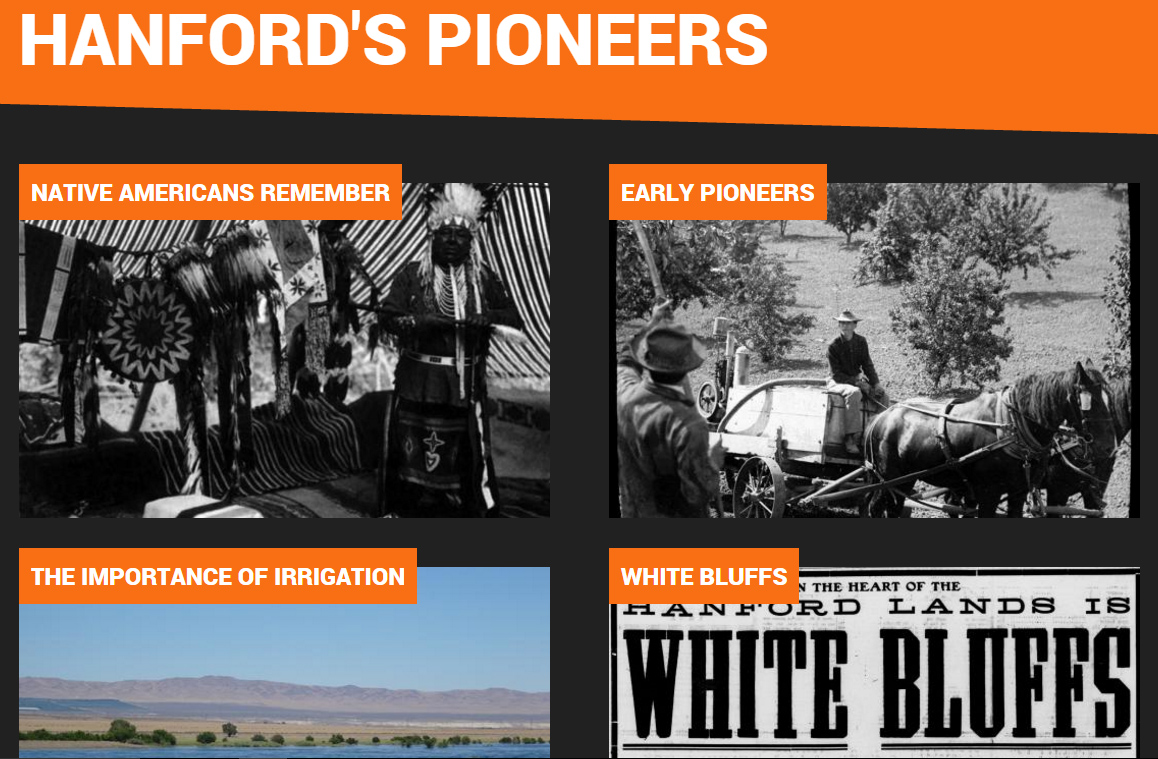The Atomic Heritage Foundation (AHF) has launched an online program called “Hanford’s Pioneers,” where visitors can hear first-hand accounts of the people who lived on the Bruggemann ranch and other pre-war sites at Hanford, WA. This release is timely as the Manhattan Project National Historical Park was officially established last week, on November 10, 2015.
In a signing ceremony in Washington, DC, Secretary of Energy Ernie Moniz and Secretary of the Interior Sally Jewell made the park official. One of the original sponsors of the legislation, Senator Maria Cantwell, spoke of the importance of creating the park, which includes many pre-war sites.
The “Hanford’s Pioneers” tour allows visitors to listen to stories from people who grew up in the towns of Hanford and White Bluffs and the Bruggemann farm, or lived in the Hanford construction camp. Visitors can choose from more than 30 short audio/visual vignettes.
In February 1943, the Army Corps of Engineers took over 670 square miles in the Columbia Basin to build top-secret industrial production plants for the Manhattan Project. Colonel Frank Matthias reported to Manhattan Project director General Leslie R. Groves that “we had found the only place in the country that could match for a desirable site. We were very enthusiastic about it.”
The program documents the sacrifices of Native Americans and early settlers who were evicted to make way for the world’s first full-scale plutonium production facilities. Before the Manhattan Project, Russell Jim, a member of the Yakama Nation, recalled, “We lived in harmony with the area, with the river, with all of the environment.” Veronica Taylor of the Nez Perce tribe recalled, “We used to camp along the riverside. There were farmers in the area that had orchards and grew fruit and vegetables. Indian people, in the early years, used to come down here and camp quite a bit and they used to fish and gather the roots and the berries.”
Pioneers first settled White Bluffs in 1861, establishing a trading post. By the 1920s, hardy farmers had begun to farm the land and develop orchards. From alfalfa to apples to peaches, the land yielded crops. Annette Heriford, whose parents owned an apple orchard at Hanford, reminisced, “I loved the orchards from the time I was a child. I really loved the valley, and still would love to go back there and live.”
Life on the frontier wasn’t easy. Robert Fletcher, whose family endured the Great Depression at Hanford, recalled, “The bedrooms were really cold in the winter when you had a cold spell. We were very self-sufficient. That’s one thing that stands out in my mind, how self-sufficient my dad and mother and all the people living in Richland were at that time.”
Paul Bruggemann bought land at Hanford in the late 1930s. He built a sturdy home of river cobble stones and began farming several hundred acres. Developing a farm takes time, and he had not yet turned a profit when the family received bad news. Paul’s son Ludwig was five when soldiers arrived at the home in two military jeeps. The Bruggemann family would have to leave the farm in two months to make way for a top-secret war project.
Thousands of people were forced off their lands to make way for the Manhattan Project. At Hanford, the towns of Hanford and White Bluffs were told to pack up their belongings. They were given minimal compensation by the government – usually around twenty-five cents an acre, which did not begin to cover the investment the farmers had made into their homes and farms. Heriford proclaimed, “Why, it was ridiculous! Ridiculous!” Meanwhile, General Groves was dismissive of the claims of the farmers: “The juries all got very compassionate as to the price of the land, so we paid an awful lot more money for it than we would have if we had just taken it ruthlessly.”
Shortly after the Army took over, the Hanford construction camp quickly mushroomed to 50,000 workers, becoming the fourth-largest city in Washington. Lawrence Denton, who moved from Idaho to take a job at the site, declared, “The construction camp was phenomenal.” Hanford was transformed in a short time from a pastoral land to a secure military and nuclear materials production site.
AHF plans to develop a full suite of Manhattan Project tours on the responsive “Ranger in Your Pocket” website. Visitors to the new park can use their smartphones and tablets to access these self-guided tours. One of the next tours will focus on Bathtub Row and other sites in the community of Los Alamos, NM. Another tour will focus on espionage and the role that spies played during the Manhattan Project.
For the “Hanford’s Pioneers” program, AHF is very grateful for grants from the City of Richland, the National Trust for Historic Preservation, the M. J. Murdock Charitable Trust, and Crystal Trust that made this project possible. Thanks to the B Reactor Museum Association for its invaluable contributions as well as the Department of Energy-Richland, Mission Support Alliance, TRIDEC, Hanford Communities, the Hanford Reach Interpretive Center and members of the Hanford History Project. Colleen French, Maynard Plahuta, Tom Marceau, Russ Fabre, Mona Wright, and Kirk Christensen deserve special thanks for their support and involvement in this production.





